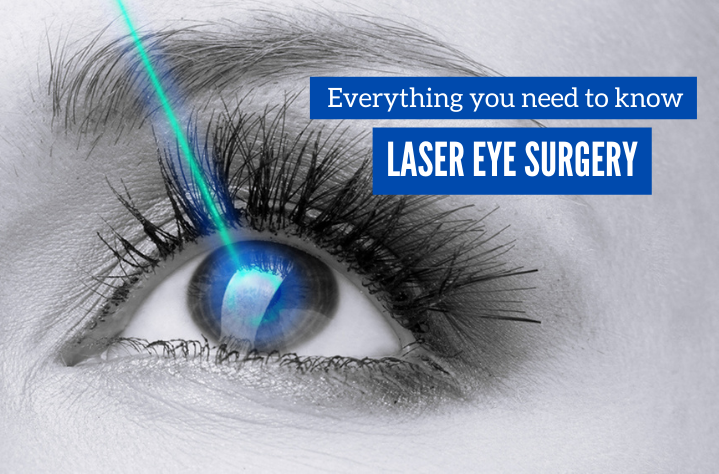Is Laser Eye Surgery Safe In The UK?

Laser eye surgery may seem like such a new procedure; however, it has been around for about 25 years. Although it may seem like something very few people know about, you may be surprised at what you find when you ask around.
The fact remains that laser eye surgery has become a routine procedure carried out several times a week in clinics and hospitals worldwide. Even though the safety of the procedure will always be a factor, the more important issue is finding out the clinics and procedures that will enable you to get the best results
Table of Contents
ToggleCalculating the risks associated with eye surgery
While we know that eye surgery, also known as refractive eye surgery or vision correction, is meant to improve one’s vision, we should also know that it falls into two categories, namely
- Laser eye surgery
- Lens surgery
Both eye surgery categories are meant to improve your vision and help you reduce your dependency on glasses. However, you should understand that only one category can suit your medical needs based on some factors like age, eye health and prescription.
To determine the right category for you, an eye surgeon will examine your eyes and help you decide
Risks associated with lens surgery
Lens surgery is one eye surgery category that improves vision by introducing a false or artificial lens into the eye. Lens surgery is of two types, the phakic intraocular lens (PIOL) surgery and the refractive lens exchange (RLE).
The PIOL surgery is a procedure based on an artificial lens implant into the eye, either in front of the eye or just behind the pupil. This is done without removing the natural lens of the eye. In a way, it is just like inserting a permanent contact lens inside the eyes. With these internal contact lenses, you have all the benefits of wearing contact lenses without drawbacks. This makes people who have a high prescription but bothered with their normal contact lenses suitable for implantable lenses. Patients who are not good candidates for laser eye surgery due to problems with their cornea can also have this option.
Risks associated with intraocular lens surgery
Although rare, there are still complications that can arise from PIOL. So said complications include infection, which is approximately 1 in 6000. This is lower compared to when you would wear typical contact lenses.
Side effects and risks also include temporary disturbance in vision and risk of developing early cataract. Furthermore, regular eye tests are important to monitor the health of the eye, particularly the cornea. Although the risks vary from person to person, eye health plays a role in reducing the risks involved.
Risks associated with refractive lens exchange
Refractive lens exchange (RLE) is also known as Lens replacement surgery or clear lens extraction (CLE) and is the same as cataract surgery, except for general refractive errors. Just like the PIOL, the RLE introduces an artificial lens into the eyes. However, the difference is that, instead of overlaying the natural lens with a new lens, it requires the removal of the natural lens and replacement with an artificial one.
Many people see RLE as a better option than PIOL, especially if you are at the beginning stage of cataract or if you are not a suitable candidate for laser eye surgery. However, RLE is not always seen as a primary choice of treatment, one of the reasons being that everyone does not tolerate it, and neither does it reduce one’s dependency on glasses. Nonetheless, there are two main types of artificial lenses used for RLE:monofocal lens and multifocal lens.
Monofocal lens
Monofocal lens only works to improve your vision froma distance. This means that the lenses provide focus only at a distance. This way, you would still need to wear glasses for working at a close range.
Multifocal lens
The multifocal lens improves your near, middle and distant vision. This lens’s problem is that about 80% of patients experience halos or rings around lights at night. Sadly, about 1 % of these affected persons may decide to undergo very risky surgery to change the lens to a monofocal one instead.
Just like PIOL, side effects can include visual discomfort in weeks or months following the procedure. Furthermore, about 1 in 500 people who have had an RLE have significant loss of vision afterwards. This is the most serious complication, according to NHS.
Risks associated with laser eye surgery
Laser eye surgery can treat almost all eye defects, including astigmatism, presbyopia, thin cornea, dry eye, and conditions that were initially deemed unsuitable for treatment.
Although it still has its limits, like not being suitable for people under 18 and requiring a stable prescription for at least a couple of years, this procedure is still safe and reliable. There are about three types of laser eye surgery, they are
PRK/LASEK: these are known as the surface treatment. They involve removing the clear layer on the outside of the cornea completely by the surgeon before reshaping the underlying tissue with a laser. The outer layer is allowed to grow back on its own; however, this can take anywhere from weeks to months and cause discomfort.
LASIK: this is the most popular laser eye surgery treatment, and it is performed using two lasers. One of the lasers is used to create a thin flap on the cornea’s surface, while the other is used to reshape the tissue underneath. This procedure is more comfortable than the LASEK, and recovery time is equally faster.
SMILE: this is the latest of the three techniques, and in this case, the surgeon uses only one laser for the whole procedure, and that is reshaping the cornea through a small laser incision that is self-healing. For this reason, procedure and healing time is shorter than the LASIK. It is mostly used for people with higher prescriptions.
The results and safety levels of all three types of laser eye surgery are similar, and this is because the vast majority of complications from eye surgery relates to the screening and assessment process.
Side effects of laser eye surgery
There are several and common side effects that people can expect to have after laser eye surgery. They include
Dry eye and visual symptoms: these occur as part of the eye’s natural healing process. Artificial tears can help with the comfort of the eyes until healing is complete. However, most of the symptoms disappear within a few days or weeks.
Night vision disturbance: night vision disturbance is common after a laser eye surgery procedure. These disturbances include glare or halos from oncoming headlights when driving at night. These usually disappear on their own after treatment.
Severe loss of vision after laser eye surgery is extremely rare.
High-quality laser eye surgery
Getting high-quality laser eye surgery involves visiting a reputed clinic. Being around for 25 years, this procedure has improved greatly in terms of performance and safety. When performed correctly and under the right conditions, these eye surgeries are safe, with minor to zero risks.
For good quality eye surgery in London, visit Optimal Vision or email to book an appointment.
Alice Christina, a seasoned health writer, combines her passion for wellness with a strong foundation in evidence-based research. She crafts insightful content that empowers readers to make informed health decisions. Alice's expertise shines through her concise and reliable health articles.
Recommended For You
Spread the loveA colposcopy is a procedure used to examine the cervix, vagina, and vulva for abnormal cells. It involves
Spread the loveAre you striving to lose weight without sacrificing your health? With weight loss advice seemingly coming from every
Spread the loveSeniors with Parkinson’s disease (PD) can lead satisfying lives, even though there is currently no cure for the





